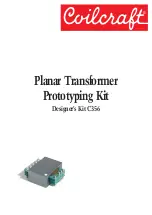
10
•
Interleave parts as much as possible. Plan the placement of parts so that
Primary Boards are separated by Stamps. In the sample transformer, each
Primary Board is placed between two Stamps. The more interleaving that
can be accomplished, the lower the leakage inductance.
The following precautions must be observed when building a prototype.
• An Insulator must be used between each part of the windings assembly
and between the assembly and each half of the core. If an insulator is
missing, the transformer will short.
• All parts in the windings assembly must be assembled so the center holes
are concentric. If the pins securing the parts together are not perpendicu-
lar to all the boards and stamps, the winding assembly is skewed and an
internal short can occur.
•
The completed windings assembly must be glued to the bottom core half.
If the assembly is allowed to float in the core, an internal short can occur.
Note: The winding assembly of the sample transformer is intentionally not
glued to the core. This allows the winding assembly to be removed
from the core to be studied.
Study the exploded view of the sample transformer and plan the order
and orientation of parts used in the prototype. Lay out all the parts in the
correct order and orientation. Review the assembly procedure for the
sample transformer. Once you are comfortable with the procedure, as-
semble your prototype.
Sample Transformer
Description
The sample transformer has a 12-turn primary and a 2-turn secondary. The
sample uses two stamps in parallel for each turn in order to lower DCR. It does
not have an Auxiliary Board. Figure 4 shows a schematic and top view of the
sample.
Note:
The windings assembly of the sample transformer has not been
glued to the core. Feel free to remove the tape securing the core
halves and remove the windings assembly to inspect.
Primary turns
12
Required DCR
60 m
⏲
⏲
⏲
⏲
⏲
Secondary Turns
2
Required DCR
0.9 m
⏲
⏲
⏲
⏲
⏲
Secondary current
30 A
Doc355.pmd
5/19/2008, 3:58 PM
10


































